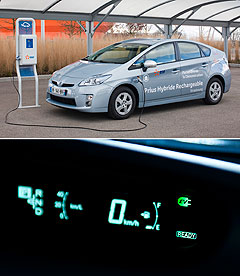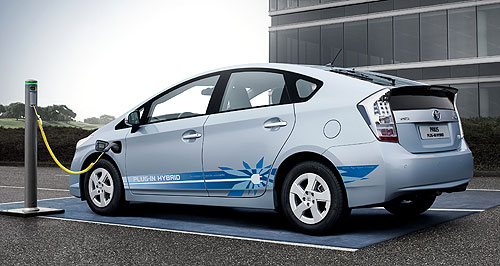Future models - Toyota - Prius - PHVToyota Prius Plug-In arrives in OzIt's here: Toyota's Prius Plug-In has arrived for field testing in Australia. Plug-in version of Toyota’s Prius formally approved for trial on Australian roads1 Jun 2010 TOYOTA has received federal regulatory approval to begin field trials of up to seven examples of its plug-in Prius hybrid on Australian roads this year. Toyota Australia spokesman Mike Breen confirmed five examples of the Prius fitted with next-generation plug-in capability have just arrived Down Under, ahead of a public-road evaluation program later this year. But he said it was “too early to talk about” when the test schedule would start and which stakeholders it would involve. The ground-breaking new Prius Plug-In was granted Australian Design Rule approval two weeks ago, when the federal government exempted it from meeting ADR 81/02 criteria, which stipulates the method used to calculate CO2 emissions and fuel and electricity consumption. Mitsubishi’s i-MiEV, the first mainstream all-electric vehicle to receive ADR approval, was expected to be the first EV to go on sale in Australia until US sportscar maker Tesla last week confirmed its plug-in Roadster will be released in August. The i-MiEV is understood to have also granted an exemption from ADR 81/02 until the design rule is amended to account for electricity use by plug-in vehicles. In Toyota’s case, the exemption is strictly limited to seven vehicles, which the federal transport department has stipulated must be leased to hand-picked candidates exclusively for testing purposes. According to federal approval documents, Toyota must not sell any of the vehicles or distribute them via dealers. It must present detail product information to candidates about fuel and energy consumption, as well as CO2 emissions and electric driving range data, and must retrieve all vehicles at the end of the evaluation process.  Toyota’s third-generation Prius is no longer the most fuel-efficient new car available in Australia but remains among the thriftiest with average fuel consumption of 3.9 litres per 100km and CO2 emissions of 89 grams per kilometre. Toyota’s third-generation Prius is no longer the most fuel-efficient new car available in Australia but remains among the thriftiest with average fuel consumption of 3.9 litres per 100km and CO2 emissions of 89 grams per kilometre.In Europe, the Prius PHV, as the plug-in version is known there, emits only 59g/km of CO2 and returns 2.6L/100km – reducing fuel consumption by almost 50 per cent – according to EU certification standards, which the Australian standard should mirror. Toyota will not say exactly when local evaluation of the Prius Plug-In will begin Down Under, but confirmed in December that Australia would be part of a global field trial of 600 prototypes from the first quarter of this year in Japan, the United States and Europe. As will be the case elsewhere, the small fleet of vehicles are likely to be entrusted to important fleet customers and government departments to test the real-world potential of the next-generation Prius. The Prius Plug-In was officially revealed at the Frankfurt motor show last September. As we’ve reported, most (230) of the vehicles will be tested in Japan, with 150 destined for the US and half the European allocation of 200 cars to go to the French city of Strasbourg for a concentrated evaluation. Australia and New Zealand will receive about half of the remaining 20. Toyota Motor Corporation says the Prius Plug-In will go on sale to retail customers earlier than expected in 2011, with sales expected to number “tens of thousands”. As with Chevrolet’s Volt, which will go on sale as a Holden in Australia in 2012, the plug-in Prius can be charged from a regular power socket as well as an on-board “range-extender” petrol engine. General Motors says a key advantage of this is the elimination of the “range anxiety” experienced by drivers of all-electric vehicles such as Nissan’s Leaf, which will also have field trials in Australia before its planned local release in 2012. The plug-in version of Toyota’s MkIII Prius, released here in July 2009, offers a full-electric driving range of 20km depending on driving conditions – up to 18km more than the standard Prius – and employs the same 73kW/142Nm 1.8-litre petrol engine and 60kW/207Nm electric motor as the standard Prius. However, it dispenses with the current Prius’ older-style nickel-metal hydride batteries in favour of new high-performance lithium-ion batteries for the first time, and can be charged from a power point in as little as 1.5 hours using a 230-volt outlet. Ni-Mh batteries are also used by the Australian-made Camry Hybrid, which went on sale in February and was not only developed with Victorian government financial support but is in line for a 2000-unit state fleet order over the next two years.  Read more25th of May 2010  Tesla set for August EV debut Down UnderUS electric vehicle leader Tesla to break new ground with 201km/h Roadster here24th of May 2010  Electric vehicle charge station powers upSydney scores Australia’s first EV charging post as ChargePoint roll out begins21st of May 2010  Toyota plugs into TeslaHybrid leader Toyota joins forces with EV pacesetter Tesla in new US joint venture14th of December 2009  Plug-in Prius for AustraliaToyota set to start fleet field trials of Prius Plug-in Hybrid in Oz next year11th of September 2009  Toyota’s plug-in Prius set for real-world trialsToyota to lease plug-in Prius hybrid from early 2010Prius pricing
Motor industry news |
Click to shareToyota modelsResearch Toyota Prius pricing
Motor industry news |
















Facebook Twitter Instagram